| 1 | The ruling serpent of Spain |
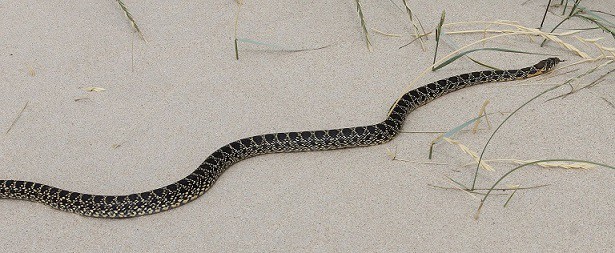
In Spain, there’s a fast-moving snake that can eat anything it wants, go anywhere it wants, and even conquer offshore islands by hiding in olive trees. This species is the horseshoe whipsnake (Hemorrhois hippocrepis), one of Spain and Portugal’s most common serpents. This is a non-venomous snake which measures 100-160cm, with an all-time record of 185.0cm reported in 1981.
Horseshoe whipsnakes appear in a variety of habitats, from rocky plains to dry grassy fields, and even towns. The only habitats they truly dislike are dark forests, as dry, open spaces are their favourites. One of their specialities is a high tolerance for hot, dry conditions. Like the coachwhip of the USA, horseshoe whipsnakes are able to slither around freely on hot roasting days, when most other Spanish snakes are hiding away in dark burrows.
The horseshoe whipsnake is a classic cross-Mediterranean species. They’re abundant in Spain and Portugal, and fail to cross the border northwards to France, blocked by the Pyrenees mountain range. However, they have powerful colonies to the south in Morocco, Tunisia and Algeria. There’s also a small colony in Sicily, but this is believed to have been artificially introduced by mankind.
Horseshoe whipsnakes often figure in the Spanish Alicante legend, an unidentified venomous snake which is subject to many folklore rhymes of fear. One goes like this: “if the Alicante bites you, call the priest to sing to you“. In reality, the horseshoe whipsnake lacks even a drop of venom, and locals may be confusing it with the venomous Lataste’s viper nearby.
| 2 | Non-venomous, but aggressive |
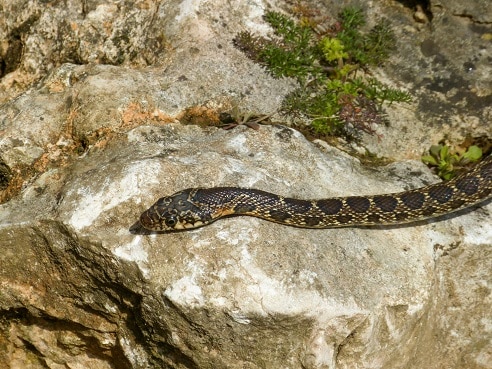
Horseshoe whipsnakes are active from mid-March onwards, entering hibernation in November, although in far southern Spain, they can be active throughout the year. This is a diurnal snake, moving and hunting by day. Nocturnal activity has been observed, but only rarely.
Unlike the Spanish montpellier snake, which has a dangerous venom, but such a small mouth it can barely bite people, the horseshoe whipsnake lacks any form of venom and has never caused a human death. This species defaults to flight above all else. When a tip-toeing human approaches, trying to stay quiet, they’ll zoom off into the undergrowth and never be seen again. Only if cornered or picked up do they turn aggressive, and in such circumstances, they can be very aggressive indeed. Hemorrhois hippocrepis will widen its head, coil up, hiss loudly, then unleash its painful, non-venomous bite.
Picking one up is a risky game. You may be lucky and experience no blowback, allowing you to investigate its complex patterns and innocent-looking eyes first hand. Or your quest may finish with a painful laceration to your wrist. Either way, horseshoe whipsnakes are neither your friend nor your enemy. They have their own business to take care of, and don’t care for blundering humans getting in their way. Hemorrhois hippocrepis also has the ability to detach its tail, by rotating its body while in a firm grip.
| 3 | Prefers mammals, but flexible |
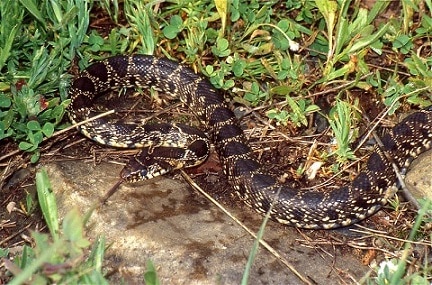
In 2004, a diet study took place in the Rif region of northern Morocco, which is relatively moist for North Africa, containing shrubland and pasture in the Atlantic-influenced west, and more arid areas in the east. 141 horseshoe whipsnakes were analysed, both dead and alive. 46 of these contained prey, mostly just a single prey, but one horseshoe whipsnake contained 2 and another 4, which consisted of 3 house sparrow chicks and one house mouse.
At 45% of prey, mammals ruled. But this was a flexible snake overall: lizards comprised 28% of prey, birds 17%, and amphibians 5%. No single prey dominated the others, not like Spain’s false smooth snake, where Iberian slow worms contributed 50% of prey. 8 mammals were identified to the species level, and at 4 discovered, the wood mouse (Apodemus sylvaticus) was the horseshoe whipsnake’s most common prey. This small scurrying creature is also confirmed prey for Spanish species like montpellier snakes and Lataste’s vipers.
Next came the black rat (Rattus rattus) and Algerian mouse (Mus spretus), at two records apiece. Iberian wall lizards (Podarcis hispanica) were discovered 3 times, making it the horseshoe whipsnake’s favourite reptile. This is also popular with Spain’s false smooth snake, so rather than an easy ride, horseshoe whipsnakes face competition for their meals.
| 4 | Avoids huge, gut-busting meals |
The study also found that horseshoe whipsnakes favoured relatively small prey. The mean length was 77.7mm, with the longest being a Norwegian rat (Rattus norvegicus) measuring 262mm. The mean prey length relative to the snake was 0.101, relatively low, while relative prey mass was similar, at 0.143. This fits neatly with its thin body, which you can easily see in photographs.
Meanwhile, the second part of the study gathered data from three older studies in Spain, compiling them into a dataset involving 247 horseshoe whipsnakes. The percentage of mammals was extremely similar at 47% (versus 45% for Morocco). But reptiles were significantly higher at 45%, birds lower at 6%, while amphibians weren’t mentioned. The last category was invertebrates at 2%.
Horseshoe whipsnakes from Morocco tended to hunt larger prey like rats, while Spanish snakes were careful not to skip smaller geckos and lizards. In Morocco, all prey (when the direction could be determined) were swallowed headfirst.
| 5 | A rare necro snake |
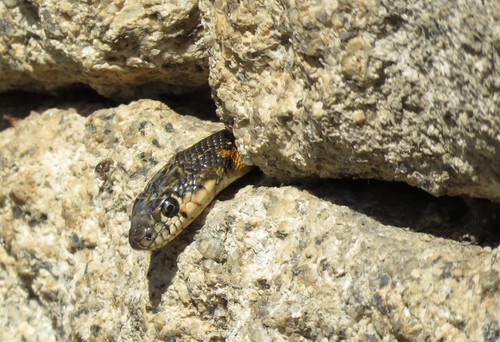
The horseshoe whipsnake has a non-fussy diet, but has one unusual feature: it’s a necro snake, with a disturbing tendency to swallow already dead prey, whether via roadkill or slashed by a bird’s talons. Snakes aren’t scavengers like vultures, and they almost always prey on live animals, but according to a study from Pantelleria, carrion made up 4 of 11 prey discovered in the horseshoe whipsnake’s diet. They knew this because fresh fly larvae was found in the dead rats they regurgitated.
The carrion consisted of 3 black rats and 1 Italian wall lizard, and the latter had clearly been killed by a car beforehand. Captive experiments confirmed their necro ways, as horseshoe whipsnakes happily swallowed dead mice which were already decomposing.
Cannibalism is also confirmed in horseshoe whipsnakes, and they occasionally hunt bats by lurking at the exits of their dark roosts. As juveniles, horseshoe whipsnakes specialise in reptiles, but shift towards mammals in adulthood. Only adults are capable of hunting birds. Horseshoe whipsnakes are a classic active forager, slowly prowling the Spanish countryside, investigating any crack or scent trail they can find. They constrict their prey, and swallowing takes 8-20 minutes.
| 6 | Invasive on Ibiza |
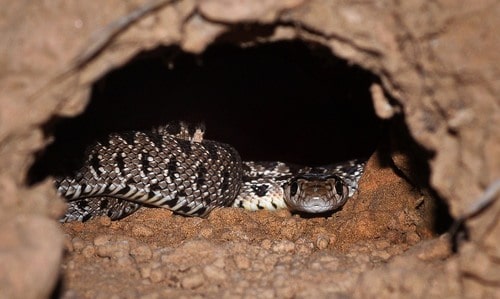
The island of Ibiza has no native snakes, except a dwarf viper which went extinct 4000 years ago. But the horseshoe whipsnake is changing all that, as since the early 2000s, it has become an invasive species on the global party hub, draping from balconies, hiding in bushes and lunging at drunken tourists from deck chairs.
Horseshoe whipsnakes have conquered all three main Balearic islands, being first detected in Ibiza in 2003, Mallorca in 2004, and Formentara in 2011. Horseshoe whipsnakes aren’t “invading” Ibiza in a carefully calculated scheme, but hiding in hollows in Spanish olive trees. When these are uprooted and planted as decorative ornaments in people’s gardens, they slither out and contribute to Ibiza’s gradually rising numbers. Ladder snakes have invaded the Balearics using similar tactics, but are not as damaging to the ecosystem, as they prey far less on reptiles.
The worst affected by horseshoe whipsnakes is the Ibiza wall lizard, a bright green or blue reptile which has been isolated in the Balearic islands for 6 million years. Over the past 20 years, they’ve suffered more than any time in their history, disappearing completely from some areas of Ibiza and Formentara. It’s possible that they’ll be wiped out altogether if the whipsnakes aren’t thwarted. Ibiza wall lizards make up 56% of the horseshoe whipsnake’s prey on Ibiza.
| 7 | But the lizards are adapting |
From 2016 to 2021, 8274 horseshoe whipsnakes and ladder snakes were removed from Ibiza and Formentara in a government-sponsored eradication, but finding all the snakes is an impossible task. Catchers can kill 15 per day, and constantly receive calls from houses. One reason for their success is a lack of predators. A 2020 study analysed the tails of horseshoe whipsnakes on Ibiza. Compared to those in mainland Spain, broken tails were far fewer, a classic sign of predator survival in older snakes.
There’s one cause for hope – rapid, hyper-pressurised evolution. Ibiza wall lizards have only co-existed with horseshoe whipsnakes for 10 lizard generations, but may already be adapting. A 2017 study tested wall lizards from Ibiza and the neighbouring islet of Sal Rossa, which lacks any snakes.
When exposed to Hemorrhois hippocrepis scents, the lizards on the islet exhibited no reaction, as with the control scent. But when the Ibiza colonies were exposed, they showed clear alarm, which they didn’t show when exposed to ladder snake scents, a species which has invaded Ibiza but rarely preys on lizards.
| 8 | Obstacles they must avoid |
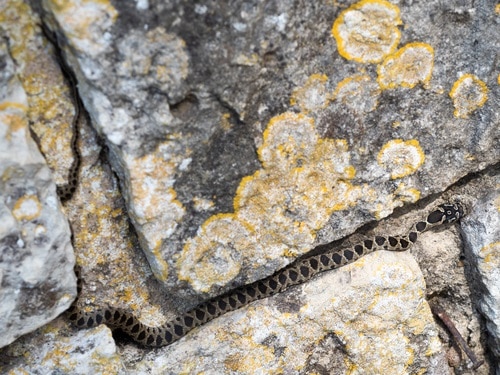
Horseshoe whipsnakes are a hardy snake, not reliant on one habitat. Due to climate change, models suggest they will become more common by 2070, not less, as average temperatures rise. A study already found that from 1940-1975 to 1991-2005, the horseshoe whipsnake expanded its territory in Spain slightly northwards.
But they’re not completely immune to threats. Their wayward ways bring them under the screeching wheels of vehicles, on the warm roads they’re drawn to. They become fatally trapped in drainage ditches and irrigation canals, or are simply beaten to death in a mistaken panic over viper attack. Herpetologists believe that the number of unusually large horsewhip snakes has decreased over the decades. It’s similar in Morocco, as the largest ones are hunted and sold to snake charmers in places like Marrakesh.
Nevertheless, horseshoe whipsnakes are a dominant, powerful species and are nowhere close to becoming endangered. Their flexible diet and preference for open areas is helping them to thrive.
| 9 | An eagle-dodging snake |
Horseshoe whipsnakes fall victim to many predators in their never-ending Spanish exploits. They have a bold personality and a love of open spaces, but the slight downside is that they’re easy for predators to spot. The montpellier snake is a species confirmed to swallow them up; this species shares its love of open, rocky habitats.
Pet cats sometimes drag horseshoe whipsnakes home, and golden eagles and Spanish imperial eagles sometimes scoop them up. But their main predator is the same as ladder snakes and montpellier snakes: the short-toed eagle (Circaetus gallicus). In a Spanish study, horseshoe whipsnakes made up 8.7% of this ophiophagous bird’s diet. The eagle preferred ladder snakes, at 39.5% of prey, but horseshoe whipsnakes still have a proper nemesis on their hands.
Without this bird, Spain would probably be completely infested with snakes. One of the few species short-toed eagles shun is the false smooth snake.
| 10 | Handy ID signs |
Horseshoe whipsnakes are thin-bodied, and are recognisable by the joined dark blotches down their spine, which resemble wonky circles. There’s 60-65 of these per snake, and they contrast sharply with a grey undertone. Horseshoe whipsnakes vary slightly, with a grey or beige undertone, but are relatively consistent in appearance overall. Those in far southern Spain and North Africa are more likely to be beige. Horseshoe whipsnakes tend to darken with age, and occasionally, you can observe almost black versions. Horseshoe whipsnakes have a long tail, comprising 22.9% of total body length.
Horseshoe whipsnakes breed frequently and enthusiastically. Most breed annually, 83.3% according to a study from southeast Iberia. Eggs are laid in batches of 3-10 and are white in colour, and semi-adhere to each other. Newborns measure 23.7-30.8cm, and usually appear from mid-August to late September.
Despite being separated by the Mediterranean ocean, there’s little genetic separation between those in North Africa and Iberia. When 37 horseshoe whipsnakes were analysed, covering 80% of the species’ territory, the maximum genetic separation was just 1.6%. Horseshoe whipsnakes are found from sea level to 1750 metres, with high observations in the Sierras Béticas mountain range of southern Spain.
